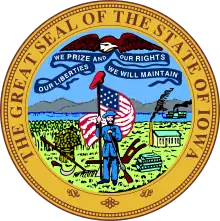1840 Iowa Council election
In the 1840 Iowa Territory Council elections, electors selected councilors to serve in the third Iowa Territory Council. All 13 members of the Territory Council were elected.[lower-alpha 3] Councilors served one-year terms.
| ||||||||||||||||||||||
All 13 seats in the Iowa Territory Council 7 seats needed for a majority | ||||||||||||||||||||||
|---|---|---|---|---|---|---|---|---|---|---|---|---|---|---|---|---|---|---|---|---|---|---|
| ||||||||||||||||||||||
| ||||||||||||||||||||||
| Elections in Iowa |
|---|
 |
The Iowa Territory existed from July 4, 1838, until December 28, 1846, when Iowa was admitted to the Union as a state. At the time, the Iowa Territory had a Legislative Assembly consisting of an upper chamber (i.e., the Territory Council) and a lower chamber (i.e., the Territory House).
Following the previous election in 1839, Democrats held a majority with seven seats to Whigs' six seats.
To claim a majority of seats, the Whigs needed to net one seat from the Democrats.
The Democrats maintained a majority of seats in the Council following the 1840 general election with the balance of power remaining unchanged with the Democrats holding seven seats and the Whigs having six seats. Whig Councilor Mortimer Phillips Bainbridge was chosen as the President of the third Territory Council to succeed Democratic Councilor Stephen P. Hempstead in that leadership position.[lower-alpha 2]
Summary of Results
Source:[4]
- Councilor Parker of Scott County.[1]
- Councilor Bainbridge of Dubuque County was chosen to be the President of the third Iowa Territory Council.[2]
- At the time, the Council had several multi-member districts.[3]
- The 1st transitioned from a 3- to 2-member district.
- Councilor Browne was an incumbent Councilor redistricted from district 2 to 1.
- The 2nd transitioned from a 1- to 2-member district.
- The 3rd transitioned from a 2- to 1-member district.
- The 4th transitioned from a 2- to 1-member district.
- The 5th was a 1-member district.
- The 6th was a 1-member district.
- The 7th was a 1-member district.
- Councilor Parker was an incumbent Councilor redistricted from district 7 to 9.
- The 8th transitioned from a 2- to 1-member district.
- The 9th was a newly created 1-member district.
- The 10th was a newly created 2-member district.
Detailed Results
- NOTE: The Iowa General Assembly does not contain detailed vote totals for Territory Council elections in 1840.
See also
External links
District boundaries for the Council were redrawn before the 1840 general election:
References
- "Councilor Jonathan W. Parker". Iowa Legislature. Retrieved July 14, 2021.
- "Councilor Mortimer Phillips Bainbridge". Iowa Legislature. Retrieved July 14, 2021.
- "Legislative Assembly: 3 (11/02/1840 - 12/05/1841)". Iowa Legislature. Retrieved July 14, 2021.
- "Legislators". Iowa State Senate. Retrieved July 14, 2021.